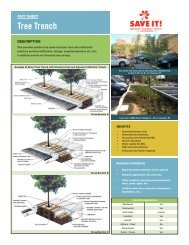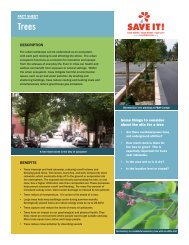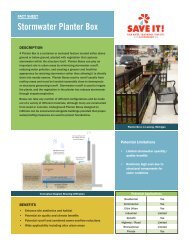Lancaster City Tree Inventory: Summary Report - Save It!
Lancaster City Tree Inventory: Summary Report - Save It!
Lancaster City Tree Inventory: Summary Report - Save It!
You also want an ePaper? Increase the reach of your titles
YUMPU automatically turns print PDFs into web optimized ePapers that Google loves.
<strong>Lancaster</strong> <strong>City</strong> – <strong>Tree</strong> <strong>Inventory</strong> and Municipal Street <strong>Tree</strong> Plan<strong>Tree</strong> Species and Age Distribution(continued)Recommendation: There is anoverabundance of maple trees, and redmaples in particular. <strong>Tree</strong> species diversityis a key to health and stability. Do not plantmore than 15% of any tree species withinthe community forest as a whole. Have aminimum of three tree species on any streetand in any tree planting project. Also try todiversify at the genus and family level, butavoid disease or pest prone species. As aresult (1) do not plant Norway maple orsugar maple on any street; (2) do not plantash as a street tree; (3) do not plant little leaflinden in areas where heat or drought arefactors (4) reduce the planting of Callerypear and red maple. In place of thesespecies, consider planting more Londonplanetree/sycamore, honey locust, andginkgo, as well as any of the less commonspecies that are acceptable, such asbasswood and tulip poplar. Reservecrabapple, cherry, and plum trees forplanting at sites where a small stature tree isnecessary. Because of concerns with Dutchelm disease and elm yellows, considerplanting small numbers of the diseaseresistantelm cultivars Triumph, NativeCharm, and Accolade.mixed-species tree population and canopy.An uneven aged forest structure will improvelandscape beauty while regulating stormdamage, tree removal, and maintenanceefforts and costs in the long run. Unevenage structure also provides for canopyreplacement as larger trees are removed. Asan example, if two percent of the total streettree population is removed each year a 50year separation in age classes would bedeveloped over time on the city streets. Thiscoupled with species diversity is the beststrategy for a healthy and well-structuredlandscape.Recommendation: The <strong>Lancaster</strong> Shade<strong>Tree</strong> Commission should work to developand use a tree planting selection list basedon the size of tree planting areas (e.g., large,medium, small, and sidewalk cutout). Thislist should provide the best quality speciesand cultivars of trees that can be planted inthe variety of landscapes found in <strong>Lancaster</strong>.Recommendation: <strong>Tree</strong> age diversity is akey to forest health and stability. Thecurrent tree inventory indicates a healthyage distribution and reflects ongoingplanting of new trees. With time andcontinued planting and maintenance, thenumber of larger, older trees will benormalized to create an even healthier agedistribution. To maintain and improve agediversity, the <strong>Lancaster</strong> Shade <strong>Tree</strong>Commission should work to prioritize andremove all risk trees annually. They shouldalso work to remove trees that are not a risk,but are of poor health, having served theiruseful life. A certain number of trees shouldbe removed each year, a certain numberplanted, and a certain number maintained.This removal and planting strategy will helpkeep the community forest safe and providea diversity of age and species for the publicforest. Age and species diversity will helpprovide a more sustainable mixed-age and18





